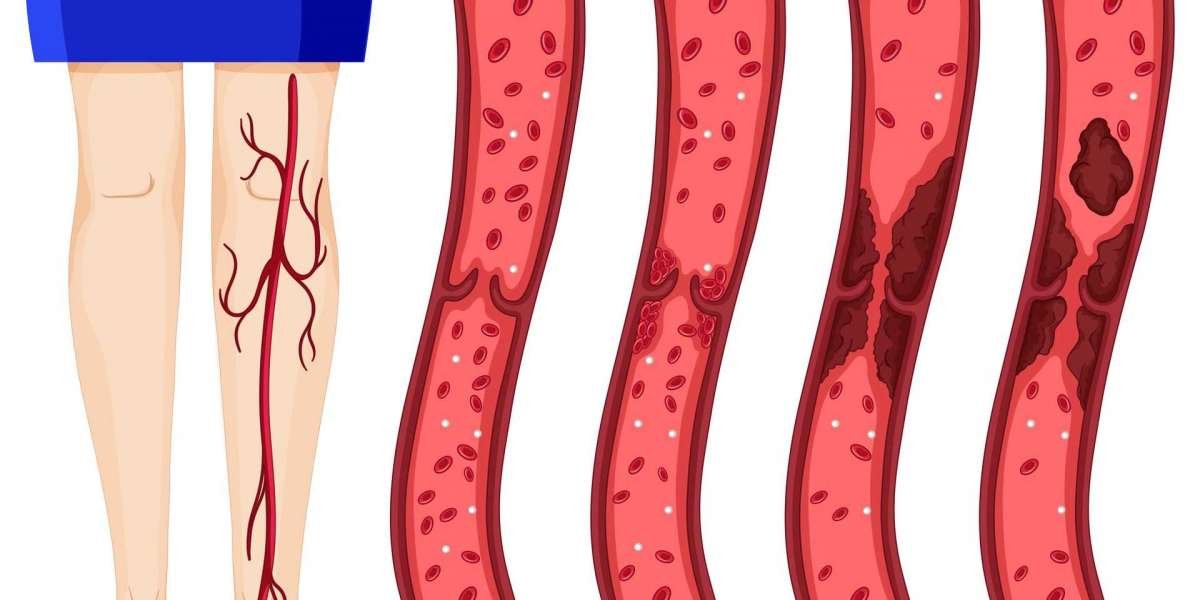Deep Vein Thrombosis (DVT) is a medical condition that often hides in plain sight. Many people walk around unaware that their body is silently developing a potentially dangerous blood clot. DVT occurs when a blood clot forms in one of the deep veins in your body, typically in the legs. While it can happen to anyone, certain people are more at risk, and recognizing DVT symptoms early can make all the difference.
In this article, we’ll break down everything you need to know about DVT—what it is, how to identify the signs, who’s at risk, and what steps you can take to prevent it. If you or someone you love is experiencing leg pain or swelling that doesn’t go away, keep reading.
What is Deep Vein Thrombosis (DVT)?
DVT is the formation of a blood clot (thrombus) in a deep vein, commonly found in the lower leg, thigh, or pelvis. Unlike surface veins, deep veins are located within muscle tissue and are vital for transporting blood back to the heart. When a clot blocks blood flow, it can cause pain, swelling, and potentially life-threatening complications like pulmonary embolism (PE)—when a clot breaks off and travels to the lungs.
Why DVT is a Silent Danger
One of the biggest challenges with DVT is its ability to develop with minimal or no warning signs. Some people may dismiss early symptoms as minor leg cramps or muscle fatigue. However, ignoring the signs can be dangerous. Left untreated, DVT can lead to long-term complications such as post-thrombotic syndrome or, worse, a fatal pulmonary embolism.
Common DVT Symptoms to Watch For
Knowing the signs of DVT can save your life or the life of someone close to you. Here are the most common DVT symptoms to watch for:
1. Leg Swelling
Swelling, typically in one leg, is one of the earliest and most noticeable signs. The swelling is often caused by the clot blocking blood flow and trapping fluid in the leg tissues.
2. Pain or Tenderness
This pain might start in the calf and feel like a cramp or soreness. It may worsen when standing or walking and ease when the leg is elevated.
3. Red or Discolored Skin
Skin over the affected area may become red or show a bluish tint. In some cases, the skin may appear shiny or warm to the touch.
4. Warmth in the Affected Limb
The leg with the clot may feel noticeably warmer than the other. This warmth is due to the inflammation triggered by the clot.
5. Visible Surface Veins
You might notice swollen or engorged veins near the skin’s surface that are more visible than usual.
Less Common But Serious Symptoms
While the above are the most recognized DVT symptoms, it’s essential to watch for signs that the clot may have traveled to your lungs. These include:
Sudden shortness of breath
Chest pain or discomfort that worsens when breathing deeply
Rapid heartbeat
Coughing up blood
These symptoms could indicate a pulmonary embolism, which is a medical emergency. Call emergency services immediately if you experience any of these.
Who is at Risk?
DVT can affect anyone, but certain conditions and lifestyle factors raise the risk:
1. Prolonged Inactivity
Long flights, bed rest after surgery, or sitting for long hours without movement can slow down blood circulation, increasing clot risk.
2. Surgery or Injury
Especially orthopedic surgeries involving the legs, hips, or abdomen. The trauma and healing process can damage veins and promote clot formation.
3. Pregnancy
Pregnant women are at increased risk due to hormone changes and added pressure on the veins in the pelvis and legs.
4. Birth Control Pills or Hormone Therapy
Estrogen-based medications can increase blood clotting tendencies.
5. Obesity
Excess weight increases pressure on veins, especially in the legs and pelvis.
6. Family History or Genetics
Inherited blood disorders or a family history of DVT increases your risk.
7. Age Over 60
Although DVT can occur at any age, your risk increases as you get older.
Diagnosing DVT
If you suspect you have symptoms of DVT, your healthcare provider will typically begin with a physical exam. They might follow up with:
Ultrasound: The most common method to detect a clot in the veins.
D-dimer Test: A blood test that measures clot-dissolving substance levels.
Venography or MRI: Less common, but sometimes necessary for a detailed view.
How is DVT Treated?
Treatment focuses on preventing the clot from growing, breaking off, and causing a pulmonary embolism. It also helps reduce the risk of future clots. Common treatments include:
1. Anticoagulants (Blood Thinners)
Medications like warfarin, heparin, or newer oral anticoagulants help prevent further clotting and allow the body to dissolve existing clots over time.
2. Compression Stockings
Wearing these helps reduce leg swelling and prevent post-thrombotic syndrome.
3. Lifestyle Changes
Increasing movement, staying hydrated, and quitting smoking all help reduce the risk of DVT recurrence.
How to Prevent DVT
Even if you're not currently at risk, it’s wise to take preventative measures:
Move Around Frequently: On long flights or car rides, walk or stretch every couple of hours.
Stay Hydrated: Dehydration can thicken the blood, making clot formation easier.
Avoid Crossing Legs for Long Periods: This restricts blood flow in your veins.
Exercise Regularly: It keeps your circulation healthy and your veins strong.
Wear Compression Socks: Particularly useful during travel or if you stand for long periods.
If you’ve had DVT before or are in a high-risk group, your doctor may recommend blood thinners or other preventive treatments.
DVT in Women: Special Considerations
Women face unique risks related to DVT. Pregnancy, birth control pills, and hormone therapy all increase clotting risk. If you're planning to become pregnant or are considering hormonal medications and have a family history of DVT, speak with your healthcare provider. Alternatives may be available that reduce your risk.
DVT in Younger Adults
While it's commonly associated with older individuals, DVT can also affect younger people, especially athletes or those with sedentary lifestyles. Being healthy doesn’t make you immune. If you’re an active gym-goer and suddenly notice leg pain, don’t ignore it—get checked out.
When to Seek Medical Help
Seek immediate help if you experience:
Unexplained leg swelling
Persistent leg pain or cramping
Changes in skin color or temperature
Shortness of breath or chest pain
Don’t attempt to diagnose yourself. It's always better to err on the side of caution and consult a healthcare provider.
Conclusion
Deep Vein Thrombosis is a condition that demands awareness. Though it often develops quietly, its consequences can be severe and even life-threatening. The key lies in recognizing DVT symptoms early and taking proactive steps to address them. Whether it’s adopting healthier habits, wearing compression socks during long trips, or simply staying more active, small changes can make a big difference.
If you suspect any symptoms discussed above, don’t wait—consult a medical professional. And remember, staying informed is the first step in protecting your health.








